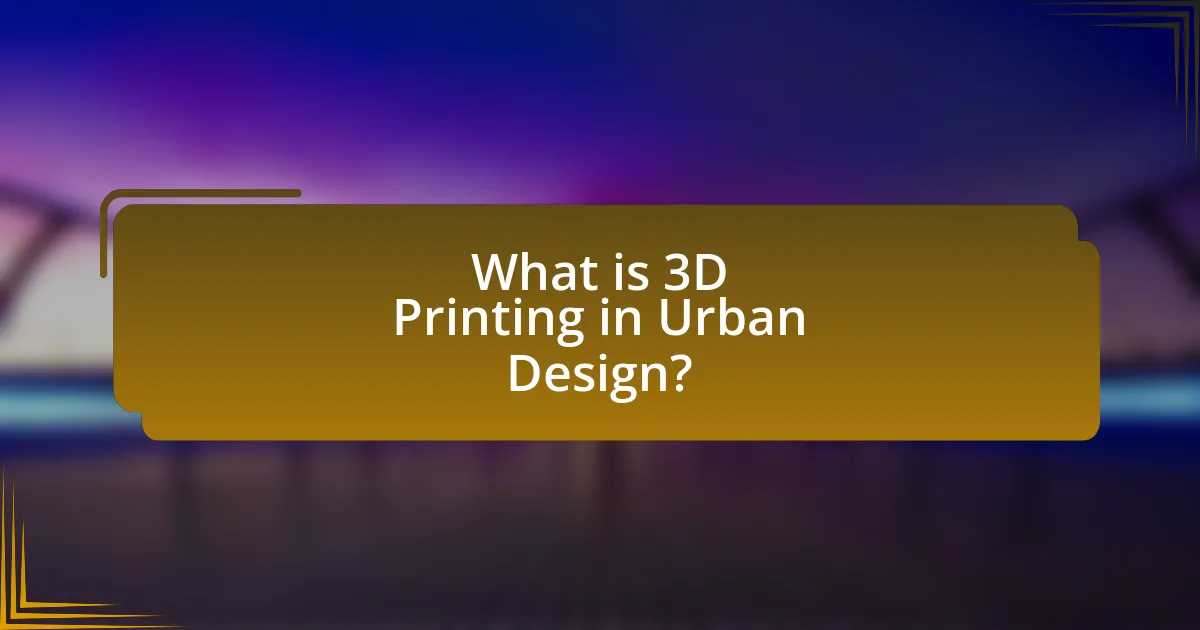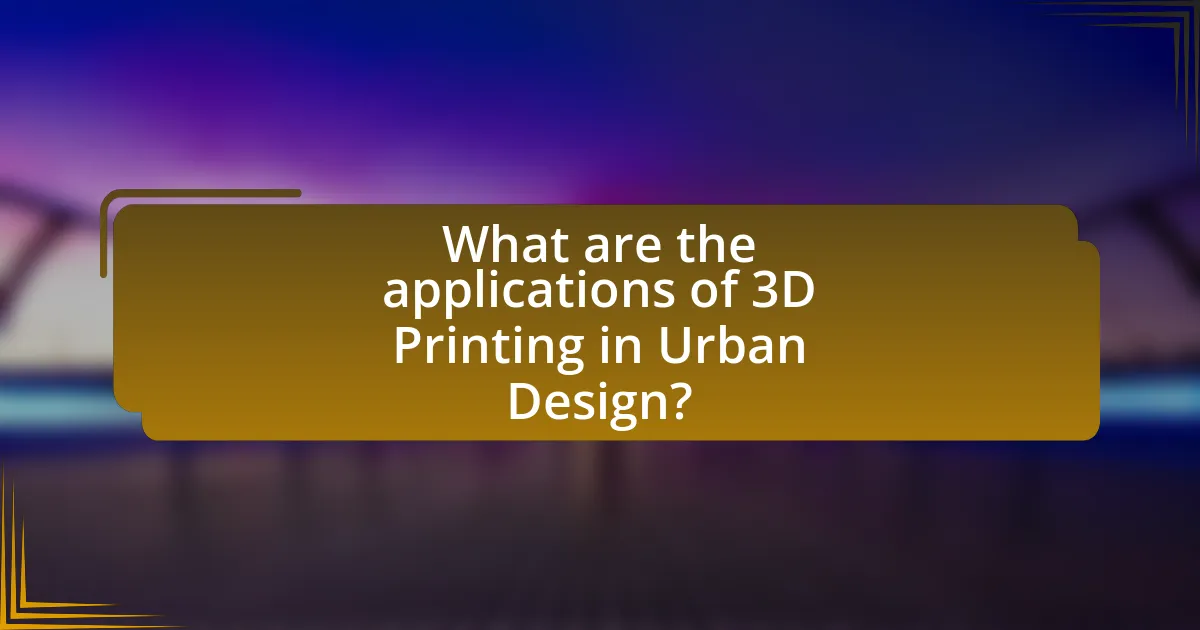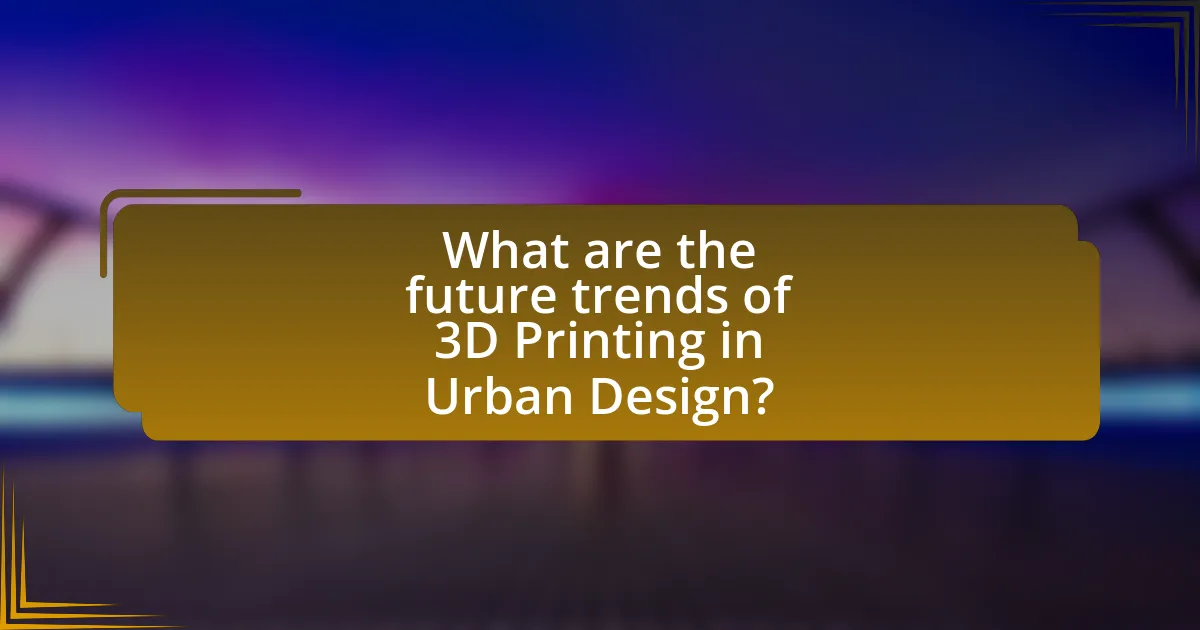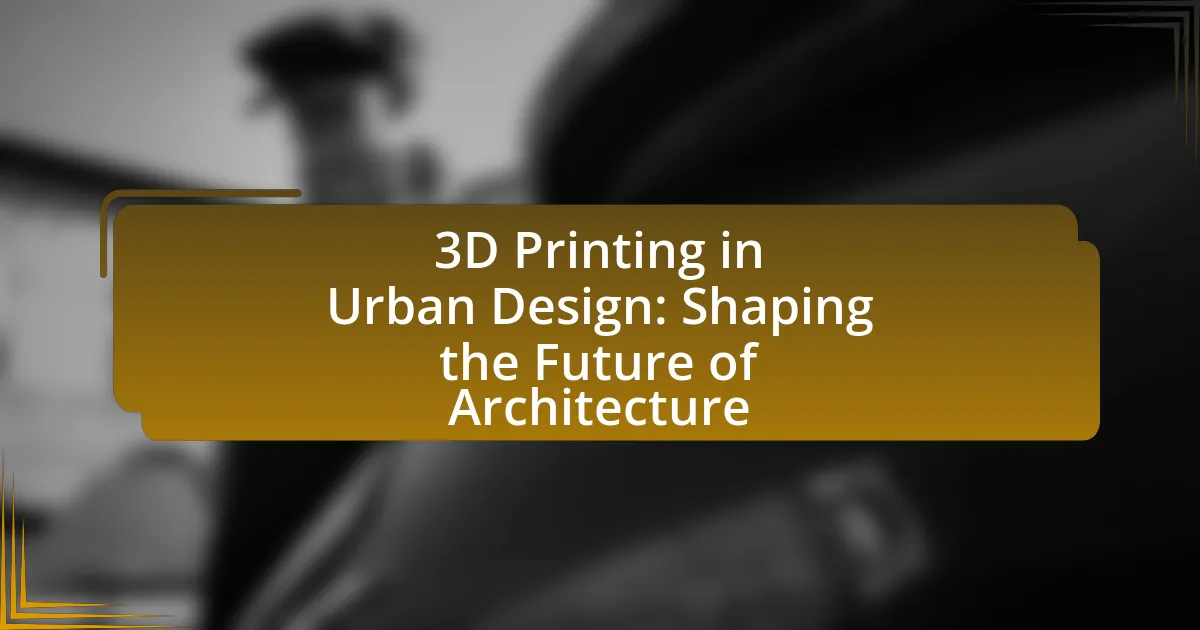3D printing in urban design refers to the application of additive manufacturing technologies to create structures and components for urban environments, significantly enhancing efficiency and sustainability in architecture. This article explores how 3D printing integrates with urban design principles, highlighting its ability to reduce construction costs and material waste while enabling rapid prototyping and customization. Key technologies such as additive manufacturing, computer-aided design, and robotic fabrication are discussed, along with their implications for community development, affordable housing solutions, and public infrastructure. The article also addresses future trends, challenges, and best practices for implementing 3D printing in urban design, emphasizing its transformative potential for the architectural industry.

What is 3D Printing in Urban Design?
3D printing in urban design refers to the use of additive manufacturing technologies to create physical structures and components for urban environments. This innovative approach allows architects and urban planners to produce complex designs with reduced material waste and shorter construction times. For instance, a study by the Massachusetts Institute of Technology highlighted that 3D printing can reduce construction costs by up to 50% and significantly decrease the time required to build structures, enabling rapid prototyping and customization in urban development projects.
How does 3D printing integrate with urban design principles?
3D printing integrates with urban design principles by enabling the rapid prototyping and construction of complex structures that align with sustainable development goals. This technology allows architects and urban planners to create customized designs that optimize space and resources, reducing material waste by up to 90% compared to traditional construction methods. Furthermore, 3D printing facilitates the use of locally sourced materials, which supports the principle of sustainability in urban design. For instance, projects like the 3D-printed Habitat for Humanity homes demonstrate how this technology can address housing shortages while adhering to urban design principles focused on community needs and environmental impact.
What are the key technologies behind 3D printing in architecture?
The key technologies behind 3D printing in architecture include additive manufacturing, computer-aided design (CAD), and robotic fabrication. Additive manufacturing allows for the layer-by-layer construction of structures using materials such as concrete, plastics, and metals, enabling complex geometries that traditional methods cannot achieve. Computer-aided design (CAD) software facilitates the precise modeling of architectural designs, which can be directly translated into 3D printing instructions. Robotic fabrication enhances the efficiency and accuracy of the printing process, allowing for the automation of construction tasks. These technologies collectively enable innovative architectural solutions, as evidenced by projects like the 3D-printed office building in Dubai, which showcases the practical application of these advancements in real-world construction.
How does 3D printing influence the design process in urban planning?
3D printing significantly influences the design process in urban planning by enabling rapid prototyping and facilitating complex geometries that traditional methods cannot achieve. This technology allows urban planners and architects to create detailed physical models quickly, which enhances visualization and stakeholder engagement. For instance, a study by the Massachusetts Institute of Technology demonstrated that 3D-printed models improved communication among project stakeholders, leading to more informed decision-making. Additionally, 3D printing reduces material waste and can utilize sustainable materials, aligning with modern urban planning goals for sustainability and efficiency.
Why is 3D printing important for the future of architecture?
3D printing is important for the future of architecture because it enables rapid prototyping, customization, and cost-effective construction methods. This technology allows architects to create complex designs that were previously difficult or impossible to achieve with traditional construction techniques. For instance, a study by the Massachusetts Institute of Technology demonstrated that 3D printing can reduce material waste by up to 60%, significantly lowering environmental impact. Additionally, 3D printing facilitates on-site construction, which can decrease project timelines and labor costs, making it a transformative tool for the architectural industry.
What challenges does traditional architecture face that 3D printing addresses?
Traditional architecture faces challenges such as high construction costs, lengthy project timelines, and design limitations, which 3D printing effectively addresses. 3D printing reduces construction costs by minimizing material waste and labor requirements, as it allows for precise fabrication of components directly from digital models. Additionally, it significantly shortens project timelines; for instance, structures can be printed in days rather than months, as demonstrated by projects like the 3D-printed house in Mexico that was completed in just 24 hours. Furthermore, 3D printing enables complex and innovative designs that are difficult or impossible to achieve with traditional methods, allowing architects to explore new forms and structures without the constraints of conventional construction techniques.
How can 3D printing enhance sustainability in urban design?
3D printing can enhance sustainability in urban design by significantly reducing material waste and enabling the use of eco-friendly materials. Traditional construction methods often result in substantial waste, with estimates suggesting that up to 30% of materials can be discarded during the building process. In contrast, 3D printing utilizes additive manufacturing techniques, which build structures layer by layer, minimizing excess material. Additionally, 3D printing allows for the incorporation of sustainable materials, such as recycled plastics and bio-based composites, which further reduces the environmental impact of construction. This approach not only conserves resources but also promotes innovative design solutions that can adapt to urban environments more efficiently.

What are the applications of 3D Printing in Urban Design?
3D printing is applied in urban design for creating architectural models, producing building components, and facilitating rapid prototyping. Architectural models made through 3D printing allow designers to visualize and communicate concepts effectively, enhancing stakeholder engagement. Additionally, 3D printing enables the production of customized building components, which can reduce material waste and construction time. Rapid prototyping through 3D printing allows for quick iterations of design, enabling urban planners to test and refine ideas efficiently. These applications demonstrate how 3D printing is revolutionizing urban design by improving efficiency, sustainability, and collaboration in the architectural process.
How is 3D printing used in the construction of buildings?
3D printing is used in the construction of buildings by enabling the rapid fabrication of structural components and entire structures through additive manufacturing techniques. This technology allows for the creation of complex designs that traditional construction methods cannot easily achieve, reducing material waste and construction time. For instance, companies like ICON have successfully printed homes in as little as 24 hours, demonstrating the efficiency and speed of 3D printing in real-world applications. Additionally, 3D printing can utilize sustainable materials, such as recycled plastics and bio-based composites, further enhancing its environmental benefits in the construction industry.
What types of structures can be created using 3D printing technology?
3D printing technology can create a variety of structures, including residential homes, commercial buildings, bridges, and sculptures. For instance, companies like ICON have successfully printed entire homes using concrete mixtures, demonstrating the feasibility of 3D-printed residential structures. Additionally, the University of Nantes has developed a 3D-printed bridge, showcasing the technology’s application in infrastructure. These examples illustrate the versatility and potential of 3D printing in modern architecture and urban design.
How does 3D printing facilitate rapid prototyping in urban design?
3D printing facilitates rapid prototyping in urban design by enabling the quick creation of physical models from digital designs, significantly reducing the time and cost associated with traditional prototyping methods. This technology allows urban designers to iterate on concepts rapidly, as changes can be made in the digital model and printed almost immediately, leading to faster decision-making and enhanced collaboration among stakeholders. For instance, a study by the Massachusetts Institute of Technology highlighted that 3D printing can reduce model production time from weeks to just hours, thus accelerating the design process and allowing for more innovative solutions in urban planning.
What role does 3D printing play in community development?
3D printing plays a significant role in community development by enabling the rapid prototyping and construction of affordable housing and infrastructure. This technology allows for the creation of customized building components with reduced material waste and lower labor costs, making it feasible for communities to address housing shortages and improve living conditions. For instance, projects like ICON’s 3D-printed homes in Austin, Texas, demonstrate how 3D printing can produce homes in a fraction of the time and cost compared to traditional construction methods, thereby fostering economic growth and enhancing community resilience.
How can 3D printing contribute to affordable housing solutions?
3D printing can significantly contribute to affordable housing solutions by reducing construction costs and time. This technology allows for the rapid fabrication of building components, which can lower labor expenses and material waste. For instance, a study by ICON demonstrated that 3D-printed homes can be constructed for as little as $10,000, showcasing a drastic reduction compared to traditional building methods. Additionally, 3D printing enables the use of locally sourced materials, further decreasing transportation costs and environmental impact. This innovative approach not only addresses the housing crisis but also promotes sustainable urban development.
What are the implications of 3D printing for public spaces and infrastructure?
3D printing significantly impacts public spaces and infrastructure by enabling rapid prototyping, customization, and cost-effective construction. This technology allows for the creation of complex designs that traditional methods cannot achieve, leading to innovative urban environments. For instance, 3D-printed structures can be tailored to meet specific community needs, enhancing functionality and aesthetic appeal. Additionally, studies indicate that 3D printing can reduce material waste by up to 90%, promoting sustainability in urban development. Furthermore, the ability to produce components on-site can decrease transportation costs and construction time, facilitating quicker project completion.

What are the future trends of 3D Printing in Urban Design?
The future trends of 3D printing in urban design include increased use of sustainable materials, integration of smart technologies, and enhanced customization capabilities. Sustainable materials, such as bio-based plastics and recycled composites, are being developed to reduce environmental impact, aligning with global sustainability goals. The integration of smart technologies, like IoT sensors, allows for real-time data collection and analysis, improving urban planning and infrastructure management. Enhanced customization capabilities enable architects and urban planners to create unique structures tailored to specific community needs, fostering innovation in design. These trends are supported by advancements in 3D printing technology, which are making the process faster, more cost-effective, and accessible for urban development projects.
How is technology evolving in the field of 3D printing for architecture?
Technology is evolving in the field of 3D printing for architecture through advancements in materials, automation, and design software. Recent developments include the use of sustainable materials such as bio-based plastics and concrete mixtures that enhance structural integrity while reducing environmental impact. Automation in 3D printing processes allows for faster construction times and increased precision, enabling architects to create complex geometries that were previously unfeasible. Additionally, sophisticated design software integrates with 3D printing technology, allowing for real-time adjustments and optimizations during the design phase. These advancements collectively contribute to a more efficient, sustainable, and innovative architectural practice.
What innovations are on the horizon for 3D printing in urban design?
Innovations on the horizon for 3D printing in urban design include the development of bio-based materials, which enhance sustainability, and the integration of smart technologies that allow for real-time data collection and analysis. These advancements aim to create more efficient construction processes and environmentally friendly structures. For instance, researchers are exploring the use of mycelium and other organic materials that can reduce carbon footprints while maintaining structural integrity. Additionally, the incorporation of sensors and IoT devices into 3D printed structures enables adaptive responses to environmental changes, improving urban resilience. These innovations are supported by ongoing research and pilot projects demonstrating their feasibility and effectiveness in real-world applications.
How might regulatory frameworks adapt to accommodate 3D printing in construction?
Regulatory frameworks may adapt to accommodate 3D printing in construction by establishing specific guidelines that address material safety, structural integrity, and building codes tailored to additive manufacturing processes. These adaptations could include the development of new standards for the materials used in 3D printing, such as concrete mixtures and polymers, ensuring they meet safety and durability requirements. Additionally, jurisdictions may implement streamlined permitting processes that recognize the unique aspects of 3D printing technology, allowing for faster project approvals. For instance, the International Organization for Standardization (ISO) has begun to explore standards for 3D printing in construction, indicating a shift towards formal recognition of this technology in regulatory practices.
What are the potential challenges and limitations of 3D printing in urban design?
The potential challenges and limitations of 3D printing in urban design include material constraints, regulatory hurdles, and scalability issues. Material constraints arise because not all construction materials are suitable for 3D printing, limiting design options and structural integrity. Regulatory hurdles exist as building codes and zoning laws may not yet accommodate 3D-printed structures, creating legal obstacles for implementation. Scalability issues are significant since while 3D printing can be efficient for small-scale projects, scaling up to larger urban developments poses logistical and economic challenges, as evidenced by the limited number of large-scale 3D-printed buildings completed globally.
What are the economic factors influencing the adoption of 3D printing?
The economic factors influencing the adoption of 3D printing include cost reduction, material efficiency, and scalability. Cost reduction is significant as 3D printing can lower production costs by minimizing waste and reducing the need for extensive tooling. For instance, a study by Wohlers Associates in 2020 indicated that 3D printing can reduce manufacturing costs by up to 70% in certain applications. Material efficiency is another factor, as 3D printing uses only the necessary amount of material, which can lead to savings in raw material costs. Additionally, scalability allows businesses to produce customized products on demand, reducing inventory costs and enabling faster market response. These economic advantages collectively drive the increased adoption of 3D printing technologies in various sectors, including urban design and architecture.
How can the industry address concerns regarding material sustainability?
The industry can address concerns regarding material sustainability by adopting eco-friendly materials and implementing recycling processes in 3D printing. For instance, using biodegradable polymers and recycled plastics can significantly reduce environmental impact. Research indicates that the construction sector, which heavily utilizes 3D printing, can lower carbon emissions by up to 80% through the use of sustainable materials (source: “Sustainable Construction Materials and Technologies,” authors: S. P. Singh et al.). Additionally, integrating life cycle assessments into material selection can ensure that sustainability is prioritized throughout the design and manufacturing processes.
What best practices should be followed when implementing 3D printing in urban design?
Best practices for implementing 3D printing in urban design include integrating sustainability, ensuring regulatory compliance, and fostering collaboration among stakeholders. Sustainability can be achieved by using eco-friendly materials and minimizing waste during the printing process, which aligns with the growing emphasis on green building practices. Regulatory compliance is crucial, as urban design must adhere to local zoning laws and building codes, ensuring that 3D-printed structures meet safety and quality standards. Collaboration among architects, urban planners, and technology experts enhances innovation and ensures that the designs meet community needs. These practices are supported by case studies, such as the 3D-printed habitat projects that have successfully demonstrated the potential for sustainable and compliant urban structures.
